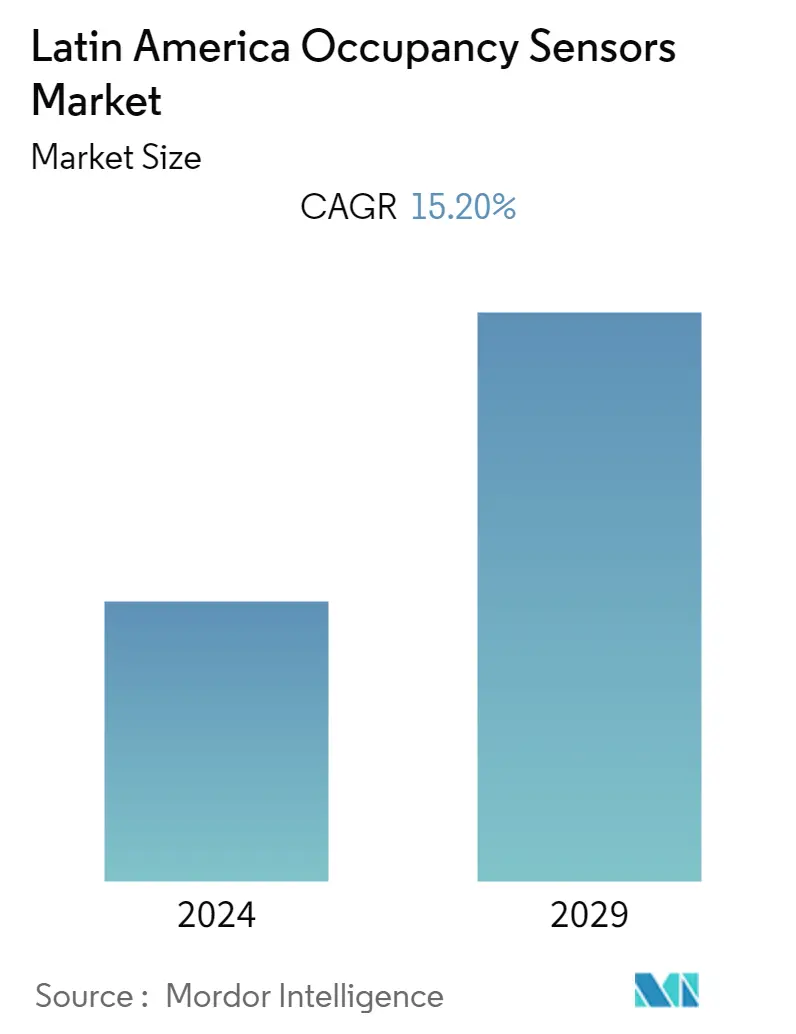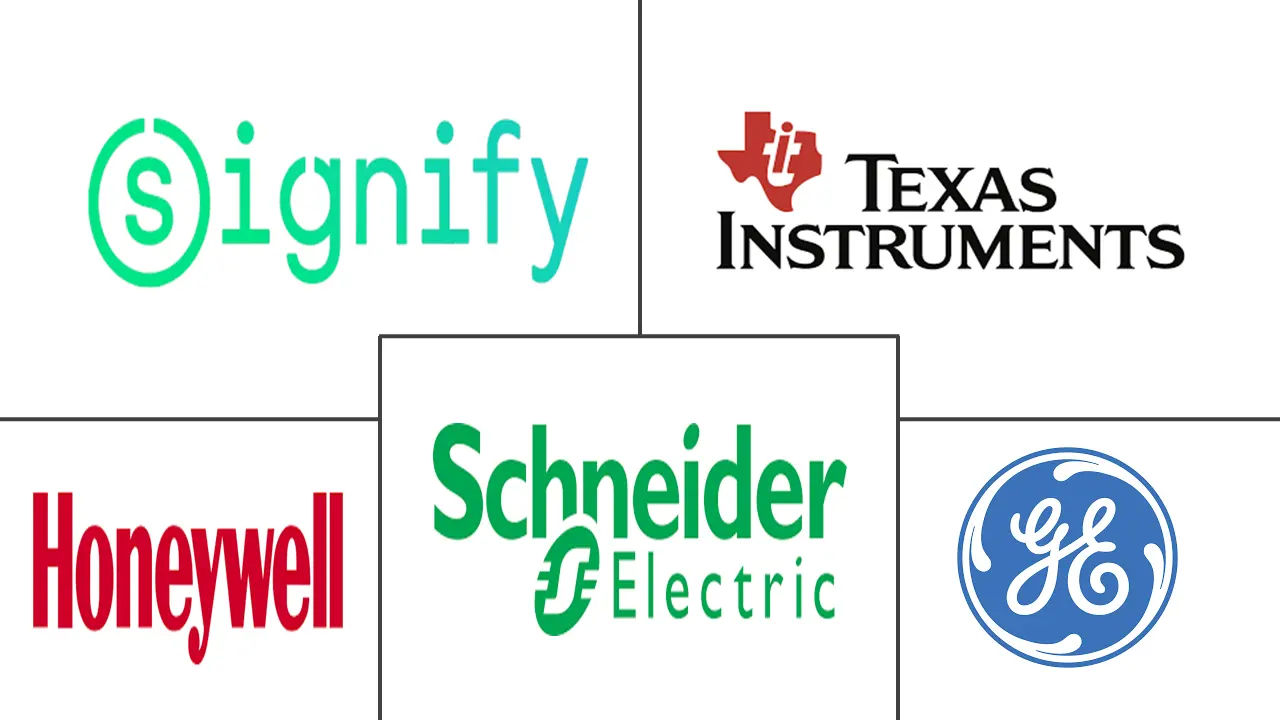Market Size of Latin America Occupancy Sensors Industry

| Study Period | 2019 - 2029 |
| Base Year For Estimation | 2023 |
| Forecast Data Period | 2024 - 2029 |
| Historical Data Period | 2019 - 2022 |
| CAGR | 15.20 % |
| Market Concentration | Medium |
Major Players
*Disclaimer: Major Players sorted in no particular order |
Latin America Occupancy Sensors Market Analysis
The Latin America Occupancy Sensors Market is expected to register a CAGR of 15.2% during the forecast period, 2021-2026. Smart building technology and occupancy sensors can provide real-time data, allowing to make better decisions for building management under the new guidelines of COVID-19. Whether saving space or improving hygiene, occupancy IoT sensors can help mobilize and optimize the back-to-work process in the region.
- The rising demand for energy-efficient devices is expected to drive the region. Occupancy sensors play a vital role in reducing energy consumption. This is achieved through the sensors, which shut down devices and other equipment based on occupancy. These sensors help reduce light pollution and can be used for indoor and outdoor spaces.
- Further, to reduce energy waste, most energy codes require some method of automatically turning off lights when they are not in use, either on a schedule or based on occupancy. Occupancy sensors are lighting controls that turn off lights in unoccupied areas, lowering energy costs by reducing energy waste. Also, various vendors in the region are introducing Ultrasonic sensors to detect the presence of people by emitting ultrasonic sound waves into the environment and measuring the speed with which they return.
- Also, there is an increasing focus on Dual-technology sensors that use both passive infrared and ultrasonic technologies to detect the presence of occupants and activate the lights only when both technologies detect the presence of occupants. This configuration virtually eliminates the possibility of false-on problems, and requiring either technology to keep the lights on significantly reduces the possibility of false-off problems.
- Occupancy sensors have primarily been used to detect motion rather than the presence or other more essential occupancy features, including count, location, track, and identity. Also, New technology is expanding rapidly to detect higher-value features of occupancy.
Latin America Occupancy Sensors Industry Segmentation
An occupancy sensor is used to save energy, comply with building codes, and provide automatic control and various other such applications. One of the most-used technologies among the occupancy sensors is the passive infrared, which detects occupancy within a specific field and activates lighting, and is extremely useful in small spaces. Moreover, the advent of advanced occupancy sensors, such as micro-phonics, intelligent occupancy sensors, image processing occupancy sensors, and the new vision-based intelligent occupancy sensor, for HVAC systems is fueling the growth of the occupancy sensor market.
| By Network Type | |
| Wired | |
| Wireless |
| By Technology | |
| Ultrasonic | |
| Passive Infrared | |
| Microwave |
| By Application | |
| Lighting Control | |
| HVAC | |
| Security and Surveillance |
| By Building Type | |
| Residential | |
| Commercial |
| By Country | |
| Brazil | |
| Mexico | |
| Argentina | |
| Rest of Latin America |
Latin America Occupancy Sensors Market Size Summary
The Latin America Occupancy Sensors Market is experiencing significant growth, driven by the increasing demand for energy-efficient devices and smart building technologies. These sensors play a crucial role in optimizing energy consumption by automatically shutting down devices and equipment in unoccupied areas, thereby reducing energy waste and light pollution. The market is witnessing a shift towards advanced technologies such as dual-technology sensors, which combine passive infrared and ultrasonic technologies to enhance occupancy detection accuracy. This evolution is supported by the growing adoption of smart lighting control systems that offer wireless and touchless control options, further expanding the market's potential. The integration of occupancy sensors in various applications, including commercial establishments and healthcare facilities, underscores their importance in enhancing energy efficiency and space management.
The market landscape in Latin America is moderately competitive, with companies focusing on product innovation, strategic partnerships, and acquisitions to maintain their market position. Notable developments include the introduction of IoT sensor packages by Signify and collaborations like that of Eyeris Technologies with Texas Instruments, which highlight the ongoing technological advancements in the sector. These initiatives are complemented by the increasing use of occupancy sensors in diverse applications, from lighting control to smart thermostats, which are becoming integral in modern building management systems. The market's growth is further bolstered by the rising awareness of energy conservation and the need for sustainable solutions across various industries in the region.
Latin America Occupancy Sensors Market Size - Table of Contents
-
1. MARKET INSIGHTS
-
1.1 Market Overview
-
1.2 Industry Attractiveness - Porter's Five Forces Analysis
-
1.2.1 Bargaining Power of Suppliers
-
1.2.2 Bargaining Power of Consumers
-
1.2.3 Threat of New Entrants
-
1.2.4 Threat of Substitutes
-
1.2.5 Intensity of Competitive Rivalry
-
-
1.3 Assessment of the Impact of COVID-19 on the Market
-
-
2. MARKET SEGMENTATION
-
2.1 By Network Type
-
2.1.1 Wired
-
2.1.2 Wireless
-
-
2.2 By Technology
-
2.2.1 Ultrasonic
-
2.2.2 Passive Infrared
-
2.2.3 Microwave
-
-
2.3 By Application
-
2.3.1 Lighting Control
-
2.3.2 HVAC
-
2.3.3 Security and Surveillance
-
-
2.4 By Building Type
-
2.4.1 Residential
-
2.4.2 Commercial
-
-
2.5 By Country
-
2.5.1 Brazil
-
2.5.2 Mexico
-
2.5.3 Argentina
-
2.5.4 Rest of Latin America
-
-
Latin America Occupancy Sensors Market Size FAQs
What is the current Latin America Occupancy Sensors Market size?
The Latin America Occupancy Sensors Market is projected to register a CAGR of 15.20% during the forecast period (2024-2029)
Who are the key players in Latin America Occupancy Sensors Market?
Signify Holding BV, Texas Instruments Inc, Schneider Electric SE, Honeywell Inc and General Electric Co are the major companies operating in the Latin America Occupancy Sensors Market.

